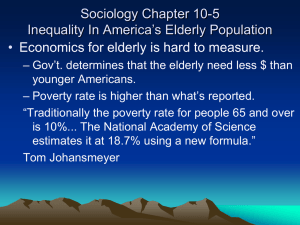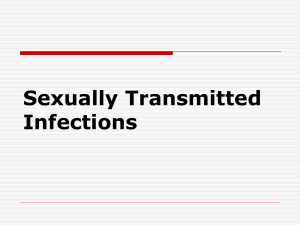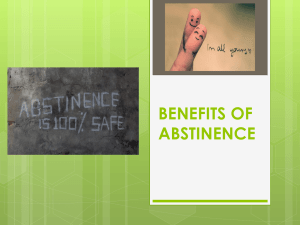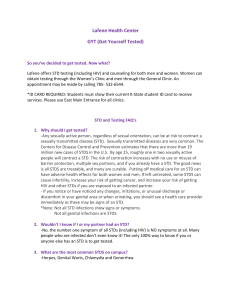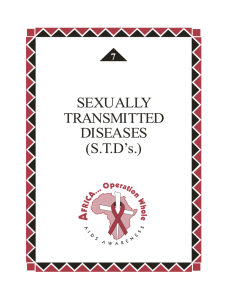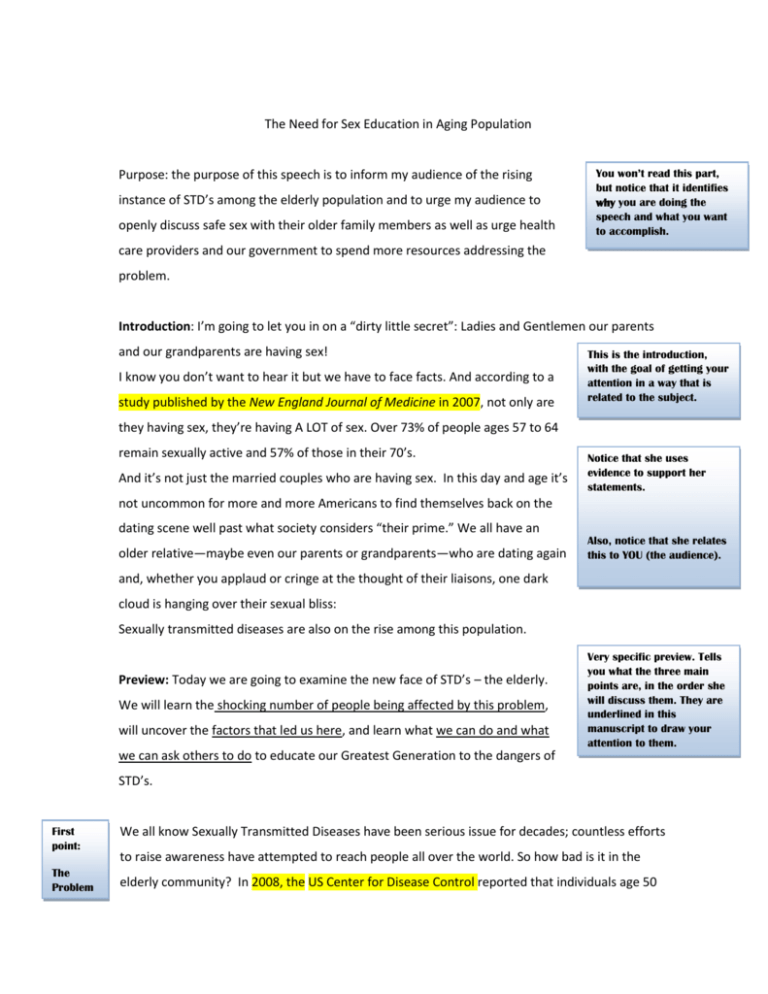
The Need for Sex Education in Aging Population
Purpose: the purpose of this speech is to inform my audience of the rising
instance of STD’s among the elderly population and to urge my audience to
openly discuss safe sex with their older family members as well as urge health
You won’t read this part,
but notice that it identifies
why you are doing the
speech and what you want
to accomplish.
care providers and our government to spend more resources addressing the
problem.
Introduction: I’m going to let you in on a “dirty little secret”: Ladies and Gentlemen our parents
and our grandparents are having sex!
I know you don’t want to hear it but we have to face facts. And according to a
study published by the New England Journal of Medicine in 2007, not only are
This is the introduction,
with the goal of getting your
attention in a way that is
related to the subject.
they having sex, they’re having A LOT of sex. Over 73% of people ages 57 to 64
remain sexually active and 57% of those in their 70’s.
And it’s not just the married couples who are having sex. In this day and age it’s
Notice that she uses
evidence to support her
statements.
not uncommon for more and more Americans to find themselves back on the
dating scene well past what society considers “their prime.” We all have an
older relative—maybe even our parents or grandparents—who are dating again
Also, notice that she relates
this to YOU (the audience).
and, whether you applaud or cringe at the thought of their liaisons, one dark
cloud is hanging over their sexual bliss:
Sexually transmitted diseases are also on the rise among this population.
Preview: Today we are going to examine the new face of STD’s – the elderly.
We will learn the shocking number of people being affected by this problem,
will uncover the factors that led us here, and learn what we can do and what
Very specific preview. Tells
you what the three main
points are, in the order she
will discuss them. They are
underlined in this
manuscript to draw your
attention to them.
we can ask others to do to educate our Greatest Generation to the dangers of
STD’s.
First
point:
The
Problem
We all know Sexually Transmitted Diseases have been serious issue for decades; countless efforts
to raise awareness have attempted to reach people all over the world. So how bad is it in the
elderly community? In 2008, the US Center for Disease Control reported that individuals age 50
and over represent more than 10% of total AIDS cases in the US and that HIV cases are
increasing among individuals in their 60’s and 70’s. During the last decade, HIV cases
have risen over 500% among senior citizens. These numbers are in direct conflict with
our preconceived ideas of the stereotypical sexual behavior of the elderly. And, believe it
or not, it’s not just the “single” folk who are contracting and spreading STD’s. Infidelity
Again, using
evidence to show
that the problem
not only exists,
but is a BIG,
significant
problem.
occurs in 20-25% of all marriages—regardless of age or number of years together. Throw into the
mix prostitution, IV drug use, and sexual experimentation, and it’s no wonder that the STD
numbers are going through the roof.
Take the case of The Villages Retirement Community: In 2006 Local 6 News in Orlando, Florida
broke the story of an upsurge in the number of herpes and human papillomavirus (HPV) cases
being diagnosed in the senior population. Similar trends are being seen in retirement
communities in Arizona, Georgia, and right here in California. Not surprisingly, the elderly are at
greater risk for serious complications from sexually transmitted disease. Those infected with HIV
carry a high mortality rate. Of those diagnosed, 37% of those individuals over 80 years old have
Using an
example
to
illustrate
the
problem.
been reported to die within a single month of diagnosis. HIV and other STD medications are hard
on an otherwise healthy body, like the young, and can exacerbate pre-existing conditions and other
chronic diseases in an elderly person.
Transition
There’s no question that STDs are a problem no matter what the age group. So how did we get
here? With record numbers of the mature and elderly population contracting Sexually Transmitted
Diseases, surely this shouldn’t be a new phenomenon. What happened in the last decade?
Second
point:
The
Cause,
broken
down
into:
A. Drugs
B. Lack
of info
Researchers and health care professionals have attributed this rise of STD cases with the
aging demographic to two main factors: the proliferation of erectile and sexual
enhancement drugs and the lack of education regarding safe sex practices.
With the all of ads on TV, radio and internet, more and more Americans are turning to
She uses an
internal
preview:
previewing the
subpoints in
this main point.
drugs to get back in the game. Foxnews reported in 2008 that prescription erectile
dysfunction drug sales in the US would top over 4.5 billion dollars that year.
ED drugs are big business. The average buyer is male aged 55 and over. Also, more and
more Americans are no longer in monogamous relationships, due to divorce, separation, or
death of their spouse or partner. Websites like eharmony and match.com report an
Again, evidence
is used.
She is
supporting her
points with
examples.
increase of the 50+ population utilizing their services.
This is also a generation of Americans who grew up before sexual education. They simply don’t
know and don’t think to ask. Most equate safe sex with birth control. Since they can no longer
become pregnant, the idea of condom use doesn’t occur to them. The stereotype of age and
sexual activity even extends to medical professionals who often don’t screen their elderly
and aging patients for STDs or ask questions about sexual history and current activity.
We, as a society, are letting our preconceived ideas about our elderly and aging
This statement
“impacts” the
audience. We
are part of the
problem.
population’s sexual activity get in the way of the safe sex practices we have been teaching
our younger populations for decades.
Transition
So, we’ve heard the numbers, we know our elderly population are contracting diseases and we
now know the biggest reasons they are contracting these diseases are due to lack of information
and the availability of pharmaceuticals to put them back in the game. So how do we stop it?
Third
point:
Solution
A. What
WE
can do
B. What
THEY
can do
In order to combat this rising epidemic of STDs in our elderly populations we first must become
comfortable about discussing it. They are having sex, they are contracting diseases, they are
spreading these diseases. We must reach out to older family members and feel comfortable about
talking with them or pointing them in the right direction where they can obtain current and factual
information. I know in many instances this is easier said than done; it’s not easy to sit down
with grandma or grandpa and ask if they know how to keep themselves safe, and if your
grandparents are anything like mine, they probably won’t pay a lot of mind to anything that
comes out of your mouth. But they do read, and will read magazines, newspapers, websites.
I’ve printed off some articles for you to take home today. If you give it to them face to face or leave
somewhere you know they will find it, hopefully they will read and understand a little bit more.
The Centers for Disease Control Website – cdc.gov—has a whole area dedicated to sexual health
for the elderly.
Also, we should encourage those we care about to reach out to their doctor or medical provider
and get information regarding safe sex practices. Locally, the Kaiser Health Foundation lists over 40
local non-profits that teach STD prevention in our community; a donation of time or money is
always appreciated and can be directed to elderly awareness.
Nationally we need to train our medical professionals to properly screen all age demographics for
sexually risky behavior. We must encourage our local and state health departments to allocate
Pre-empts a
possible
objection:
“I don’t want to
talk to them.”
more dollars towards STD awareness, much like New York City. The New York City Department of
Health allocated 1 million dollars in 2008 for an elderly awareness and screening
program. They held information sessions at senior centers across the city and handed
out free condoms as well as provided free HIV screenings. STD awareness increased
Showing it will
work,
specifically how
it worked
elsewhere.
over 47% because of this program. Programs like these would be immensely helpful in
combating the rise of STDs in this demographic.
Summary: You’ve know heard the numbers, it is undeniable that sexually
transmitted diseases are a serious problem in our senior community. You’ve
heard how drugs like Viagra combined with a lack of proper sexual education has
exacerbated this epidemic, and you know what you can do and what we can ask
others to do to solve this problem.
Very specific summary,
reminding you of the
three main points
addressed in the speech
(in the order she
addressed them). They
are underlined in this
manuscript to draw your
attention to them.
Conclusion: I hope that I made you uncomfortable today. Whether you leave here uncomfortable
in the knowledge that your older family members are having sex on a pretty regular basis; or the
fact that that our elderly population is being stricken with preventable diseases, I hope that you are
unsettled. I hope that you will now have the courage to look beyond your own preconceived ideas
and stereo types and take action on behalf of your loved ones and our community.






